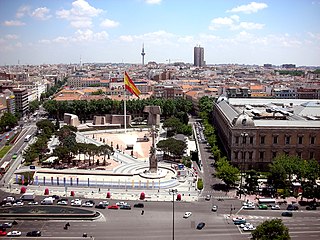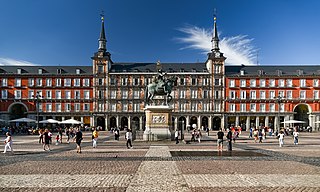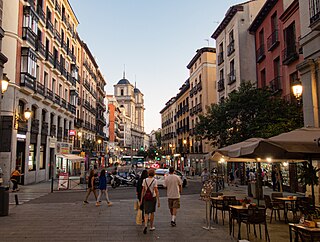
The Paseo del Prado is one of the main boulevards in Madrid, Spain. It runs north–south between the Plaza de Cibeles and the Plaza del Emperador Carlos V, with the Plaza de Cánovas del Castillo lying approximately in the middle. The Paseo del Prado forms the southern end of the city's central axis. It enjoys the status of Bien de Interés Cultural (BIC), and as part of a combined UNESCO World Heritage Site with Buen Retiro Park.

Plaza de Colón is located in the encounter of Chamberí, Centro and Salamanca districts of Madrid, Spain. This plaza and its fountain commemorate the explorer Christopher Columbus, whose name in Spanish was Cristóbal Colón.

The Plaza Mayor is a major public space in the heart of Madrid, the capital of Spain. It was once the centre of Old Madrid. It was first built (1580–1619) during the reign of Philip III. Only a few blocks away is another famous plaza, the Puerta del Sol.

Agustí Querol i Subirats was a prominent Spanish sculptor, born in Tortosa, Catalonia, Spain.
Juan Gómez de Mora (1586–1648) was a Spanish architect, active in the 17th century. He was a main figure of Spanish early-Baroque architecture in the city of Madrid. Spanish art historian Virginia Tovar Martín has published scholarly works on Gómez de Mora.

Plaza Degetau, formally Plaza Federico Degetau, is the larger of two plazas at Plaza Las Delicias, the main city square in the city of Ponce, Puerto Rico. The other plaza is named Plaza Muñoz Rivera and is located north of Plaza Degetau. The square is notable for its fountains and for the various monuments it contains. The historic Parque de Bombas and Ponce Cathedral buildings are located bordering the north side of this plaza. The square is the center of the Ponce Historic Zone, and it is flanked by the historic Ponce City Hall to the south, the cathedral and historic firehouse to the north, the NRHP-listed Banco Crédito y Ahorro Ponceño and Banco de Ponce buildings to the east, and the Armstrong-Poventud Residence to the west. The square dates back to the early Spanish settlement in Ponce of 1670. It is the main tourist attraction of the city, receiving about a quarter of a million visitors per year.

Paseo del Prado is a street and promenade in Havana, Cuba, near the location of the old city wall, and the division between Centro Habana and Old Havana. Technically, the Paseo del Prado includes the entire length of Paseo Martí approximately from the Malecon to Calle Máximo Gómez, the Fuente de la India fountain. The promenade has had several names; it was renamed Paseo de Martí in 1898 with the island's independence from Spain. Despite the historic references, the people of Havana simply call it "El Prado".

The Fountain of Cybele in Mexico City is a bronze statue installed in Colonia Roma in 1980, and refurbished in 2011. A symbol of brotherhood between the Spanish and Mexican communities, it is a replica of the fountain located in the Plaza de Cibeles in Madrid that was built by architect Ventura Rodríguez between 1777 and 1792. The Mexican version is located at a traffic circle in Plaza Villa de Madrid, where Oaxaca, Durango, Medellín and El Oro streets converge in Colonia Roma. The plaza and statue are considered emblematic sights of Mexico City.

The architecture of Madrid has preserved the look and feel of many of its historic neighbourhoods and streets, even though Madrid possesses a modern infrastructure. Its landmarks include the Royal Palace of Madrid, the Royal Theatre with its restored 1850 Opera House, the Buen Retiro Park, the 19th-century National Library building containing some of Spain's historical archives, a large number of national museums, and the Golden Triangle of Art located along the Paseo del Prado and comprising three art museums: Prado Museum, the Reina Sofía Museum, and the Thyssen-Bornemisza Museum, which completes the shortcomings of the other two museums. Cibeles Palace and Fountain have become the monument symbol of the city.

The Old Cathedral of Plasencia is a Roman Catholic church in Plasencia, Cáceres Province, Extremadura, Spain. It is one of two cathedrals in Plasencia, the other being the New Cathedral.

The Statue of the Bear and the Strawberry Tree is a sculpture from the second half of the 20th century, situated in the Spanish capital, Madrid. It represents the coat of arms of Madrid and is found on the east side of the Puerta del Sol, between Calle de Alcalá and Carrera de San Jerónimo, in the historical centre of the capital.

The Walls of Felipe IV surrounded the city of Madrid between 1625 and 1868. Philip IV ordered their construction to replace the earlier Walls of Philip II and the Walls del Arrabal, which had already been surpassed by the growth of population of Madrid. These were not defensive walls, but essentially served fiscal and surveillance purposes: to control the access of goods to the city, ensure the collection of taxes, and to monitor who went in and out of Madrid. The materials used for construction were brick, mortar and compacted earth.
The Fuente de las Ranas is an emblematic fountain located in center of the Spanish city of Albacete. Built in memory of Dionisio Guardiola, was inaugurated in 1916 in the center of the current Plaza de Gabriel Lodares, having chaired several places in the city until, in 2007, it was moved to its current location, the roundabout between the Paseo de la Libertad, the Avenida de la Estación, the Paseo de la Cuba and Calle Alcalde Conangla.

The Towers of the churches of San Salvador and Santa Cruz were the towers of the destroyed churches of San Salvador and Santa Cruz located in Madrid.

The Fountain de La Mariblanca was a fountain located in Puerta del Sol, in Madrid. Now demolished. Not to be confused with other fountains located in Madrid and Spain with the same name.

Valencian Art Nouveau is the historiographic denomination given to an art and literature movement associated with the Art Nouveau in the Valencian Community, in Spain.

The Calle de Toledo is a historic street in central Madrid, Spain, running across the Centro and Arganzuela districts.

The Monument to the Heroes of Puente Sampayo is a memorial and sculptural group created by the Spanish sculptor Julio González Pola, in Pontevedra, Spain.

The Praza da Ferrería is a large square located on the edge of the old town of Pontevedra (Spain), inside the old city walls. It is the main square of the old town and has an area of about 2,000 m2. It includes the small squares of the Estrella on the north side, the Orense square on the south side and the Casto Sampedro square on the east side, making a total of almost 5,000 m2.

The history of the Puerta del Sol represents an essential part of the memory of the Villa de Madrid, not only because the Puerta del Sol is a point of frequent passage, but also because it constitutes the "center of gravity" of Madrid's urban planning. The square has been acquiring its character as a place of historical importance from its uncertain beginnings as a wide and impersonal street in the sixteenth century, to the descriptions of the first romantic travelers, the receptions of kings, popular rebellions, demonstrations, etc. It has been the scene of major events in the life of the city, from the struggle against the French invaders in 1808 to the proclamation of the Second Republic in 1931, and it has also retained its place as the protagonist of the custom of serving Twelve Grapes on New Year's Eve, to the sound of the chimes struck by the Correos clock. Nowadays it is a communications hub, a meeting point, a place of appointments, a place for celebrations and the beginning of demonstrations in the Capital.



















